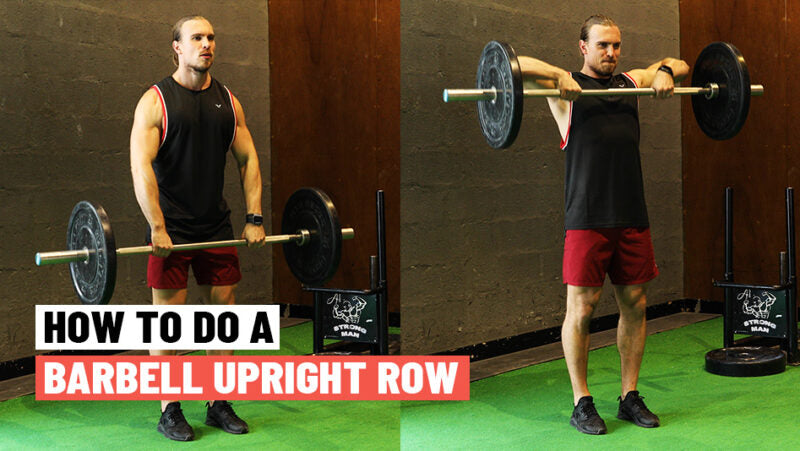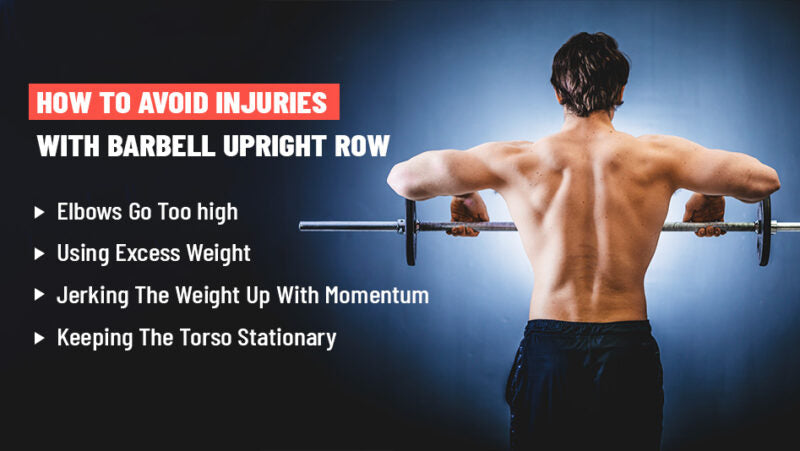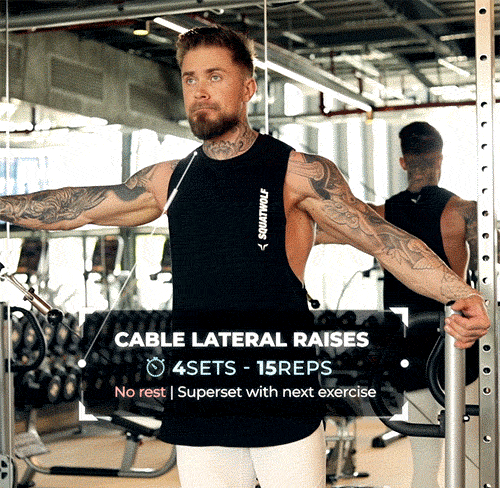Summary
The upright row is a staple in many strength training routines. It targets your shoulders and enhances upper body aesthetics. To reap its full benefits, you need to master its proper form. This will also prevent injuries.
Learn more about the benefits of and common mistakes when doing upright rows. Discover alternatives like face pulls, cable lateral raises, reverse fly and more to optimize your shoulder training!
Mastering the Form

Muscles Worked
- Shoulder Rows: The primary muscles activated when performing the upright row. They are essential for shoulder elevation and contribute to the defined shape of the upper back.
- Upright Raise Muscles: These include the deltoids, especially the lateral and anterior parts, and play a pivotal role in shoulder abduction.
- Traps (Trapezius): This muscle runs down the back of the neck and upper spine, and it's responsible for the shrugging and upward motion of the shoulders during the upright row.
Step-by-Step Instructions
- Stance: Stand with feet shoulder-width apart, holding the barbell in front of you using an overhand grip.
- Initial Pull: Using the strength of your shoulder rows, lift the barbell straight up while keeping it close to your body. Your elbows should drive the motion, pointing outwards and upwards.
- Peak Position: As the barbell approaches chest level, don’t let your hands surpass your elbows in height. This maintains a proper upright row form and minimizes the risk of injury.
- Return: Lower the barbell back to the starting position slowly, maintaining control throughout.
Remember: Always consult a fitness expert when trying a new exercise to ensure you've mastered the upright barbell row form. If you’re a complete beginner, you could also hire a personal trainer.

New to working out? Sculpt your shoulders with resistance band shoulder workouts!
Choose The Right Fitness Gear
Maximizing the potential of your workouts goes beyond perfecting the upright row form or mastering how to do upright rows. While technique is fundamental, the attire you choose plays a significant role in your performance, ensuring you stay comfortable and unrestricted during intense sessions.
Gym Clothes for Men
It's essential to look for materials that offer breathability, durability, and flexibility. Men often prefer clothing that offers moisture-wicking, especially during intense exercises like the barbell pull up row or standing barbell upright row. Some top recommendations include:
- Tanks & Stringers: Offering free range of movement, making exercises like the shoulder row or upright shoulder row feel seamless.
- Shorts: Perfect for leg day, providing the needed stretch and mobility.
Check out the full range of men's gym wear to elevate your training sessions.
Workout Clothes for Women
For women, the right workout clothes should offer both style and functionality. Whether you're perfecting the upright barbell row form or engaging in a series of upright raises, comfort is key. Key items every woman should consider:
- Workout Leggings: These offer compression and support, crucial for exercises like upright barbell rows and squats.
- Sports Bras: They provide the necessary support, especially during high-intensity sessions involving exercises like the barbell upright row.
Explore the extensive collection of workout clothes for women for a blend of fashion and functionality.
Common Mistakes and Ensuring Proper Form

The upright row form is paramount when aiming for effective shoulder development and avoiding potential injuries. Many individuals, whether novices or seasoned gym-goers, make common errors that can compromise their progress and safety. Here's how to identify and correct these common missteps:
Elbows Go Too High: The Standing Barbell Upright Row Error
One common mistake while performing the standing barbell upright row is elevating the elbows too high. It's imperative to maintain a balance:
- Correct Form: Elbows should be in line with your shoulders, not exceeding them.
- Potential Risk: Elevating them too high can lead to shoulder impingement.
Build your delts with these top 3 deltoid exercises.
Using Excess Weight: How it Affects the Barbell Pull Up Row
Using too much weight in exercises, especially in the barbell pull up row, can do more harm than good:
- Form Compromise: Excess weight usually leads to a breakdown in form, reducing the effectiveness of the upright row barbell exercise.
- Potential Risk: It increases the chances of shoulder and back injuries.
- Recommendation: Lighten the load and prioritize the upright barbell row form.
Diversify your shoulder training with these 4 cable shoulder workouts.
Minus The Momentum: Keeping Your BB Upright Row Stable
Using momentum, particularly in the bb upright row, might feel like you're lifting more, but it's usually counterproductive:
- Correct Technique: Use a controlled motion to work the intended muscles effectively.
- Potential Drawback: Relying on momentum can reduce muscle engagement and increase injury risk.
Want to build those shoulder boulders? Try this explosive shoulder workout.
Benefits

The barbell upright row is more than just another exercise to add to your routine—it's a powerhouse movement with a range of benefits. Here's what makes this exercise indispensable:
Increase Shoulder Size and Strength
Diving into the upright shoulder row, there's more than meets the eye:
- Muscle Engagement: It directly targets the deltoids, enhancing your shoulder growth.
- Strength Gains: Regularly incorporating this exercise results in significant improvements in shoulder power and resilience.
Enhance Shoulder Stability
Stability is a cornerstone of effective training, and upright barbell rows deliver on this:
- Joint Support: It strengthens the muscles around the shoulder joint, providing better support and reducing injury risk.
- Functional Fitness: Enhanced stability translates to better performance in daily activities and other workouts.
Improve Your Posture
Good posture isn't just about aesthetics—it's essential for overall health, and the barbell upright row contributes significantly:
- Spinal Alignment: Strengthening the upper back and shoulder muscles helps maintain a straighter spine.
- Reduces Strain: A better posture means reduced strain on the neck and lower back.
- Technique Matters: Ensuring proper upright row form is key to reaping these posture benefits.
Build Impressive Traps
If you want that sculpted upper back look, the upright row barbell exercise is your ally:
- Targeted Growth: It directly engages the trapezius muscles, leading to noticeable size and definition.
- Compound Movement: Being a multi-joint exercise, it also works surrounding muscles, offering a comprehensive workout.
- Progressive Overload: Gradually increasing weight with proper barbell upright row form ensures consistent trap development.
Alternative Exercises
While the upright row barbell exercise is great for developing shoulders and traps, it's always a good idea to add some more exercises in your routine. You can add the following alternatives in your shoulder routine:
1. Face Pull

- Setup: Stand in front of the cable machine with a rope attachment at face height.
- Execution: Hold the rope’s ends with both hands, pull it towards your face, squeezing your shoulder blades together.
- Benefits: Besides strengthening your rear delts, it also improves your shoulder posture.
Check out our complete guide on shoulder workout for women for toned arms.
2. Cable Lateral Raise

- Setup: Stand on the side of the cable machine with the extension set to the lowest setting.
- Execution: Grab the handle with one hand and keep your arm straight. You can also hold the cable’s side bar for support. Lift the handle out to the side until it's at shoulder height, then lower back down.
- Benefits: Targets the middle deltoid, providing a well-rounded shoulder appearance.
Intensify your shoulder workouts with these battle rope exercises.
3. Barbell Front Raise

- Setup: Hold a barbell with an overhand grip, hands shoulder-width apart.
- Execution: Keep your arms straight and raise the barbell in front of you until it reaches eye level. Slowly lower it back down.
- Benefits: Primarily targets the front deltoid.
Add this effective kettlebell swing workouts to build more muscle and achieve overall fitness.
4. Dumbbell Lateral Raise

- Setup: Stand with a dumbbell in each hand by your side.
- Execution: Keeping your arms straight, raise the dumbbells out to the side until they're at shoulder height.
- Benefits: Focuses on the lateral deltoid, enhancing the shoulder's width.
Complement this with a solid dumbbell back workout for a balanced upper body development.
5. Machine Reverse Fly

- Setup: Sit on the machine with your chest against the pad. Grab the handles with your arms extended in front of you.
- Execution: Pull the handles out and back, squeezing your shoulder blades together.
- Benefits: It mainly works the rear deltoids.
Don’t feel comfortable with machines yet? Try dumbbell bent over fly instead.
Key Takeaways
Getting your form on the upright row right is vital for building strong and defined shoulders. The barbell upright row isn't just about lifting, but lifting correctly. If your goal is engage your muscle and get that sculpted look, then add variations like the standing barbell upright row.
It’s important to understand how to do an upright row and its alternatives correctly to truly enhance both strength and workout balance. Remember, to achieve your fitness goals, you need to stick by commitment and knowledge!
Frequently Asked Questions
What muscles do upright rows work?
The main muscles the upright row barbell exercise targets are the deltoids, specifically the lateral or "side" deltoids. This exercise also engages the trapezius, rhomboids, and biceps. Proper upright row form makes sure that these muscles are engaged effectively, leading to better strength and muscle definition over time.
Are upright rows good for building shoulders?
Yes, barbell upright rows are an effective exercise for building your shoulders and upper back muscles. When executed with the correct upright row form, this exercise significantly enhances your shoulder strength. It improves your overall posture and helps in building a well-defined upper body. However, it's crucial to follow proper guidelines on how to do an upright row to maximize benefits and minimize the risk of injuries. Incorrect form often leads to injuries.
Which is better: upright row or shoulder press?
Both the upright row and the shoulder press are excellent exercises for targeting the shoulders. But they serve different purposes and activate different muscles within your upper body. The upright row primarily works the deltoids, traps, and the biceps. It focuses on the upper trapezius. On the other hand, the shoulder press is more focused on the anterior and medial deltoids. Whether one is "better" than the other depends on your specific fitness goals. It also depends on which muscles you're focusing on. For a comprehensive shoulder workout, it's beneficial to incorporate both exercises for a full-fledged, comprehensive shoulder workout. Always remember to maintain proper upright row form and shoulder press technique to prevent injuries. If you're focusing on building upper body strength, you can add upright rows into your back workout routine as well.
Do upright rows work the biceps?
Yes, the upright row does engage the biceps. But biceps are not the primary muscle it works. When you perform an upright row, the main muscles it targets are the deltoids and the trapezius. However, as you pull the barbell or weights upward, the biceps act as a secondary muscle group, assisting in the lifting motion. While the engagement of the biceps is not as direct as in bicep exercises like curls, they still play a supporting role in the upright row barbell movement. If you're looking to specifically target the biceps, then you need to incorporate bicep exercises into your routine.
Should I go heavy on upright rows?
Going heavy on upright rows depends on your fitness goal, fitness level, experience, and form. While increasing weight leads to muscle growth and strength gains, it's important to maintain the correct upright row form throughout your movement. Lifting heavy weights without proper form strains the shoulders and leads to potential injuries. For those new to the upright barbell row, it's best to start with lighter weights, focusing on the technique instead. Once you're confident in your form, you can progressively overload by increasing the weight. You can also increase your reps while keeping the same weight. Always prioritizing safety and listening to your body. If you experience any discomfort or pain during the movement, it's a sign to reduce the weight and work on your technique.






